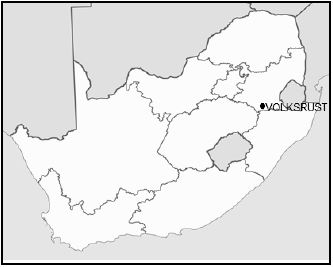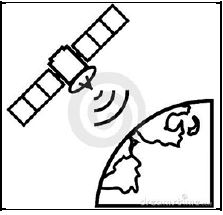GEOGRAPHY PAPER 2 GRADE 12 QUESTIONS - NSC PAST PAPERS AND MEMOS FEBRUARY/MARCH 2017
Share via Whatsapp Join our WhatsApp Group Join our Telegram GroupGEOGRAPHY
PAPER 2
GRADE 12
NSC PAST PAPERS AND MEMOS
FEBRUARY/MARCH 2017
RESOURCE MATERIAL
- An extract from topographical map 2729BD VOLKSRUST.
- Orthophoto map 2729 BD 13 VOLKSRUST
- NOTE: The resource material must be collected by schools for their own use. 3.
INSTRUCTIONS AND INFORMATION
- Write your EXAMINATION NUMBER and CENTRE NUMBER in the spaces on the cover page.
- Answer ALL the questions in the spaces provided in this question paper.
- You are provided with a 1 : 50 000 topographical map (2729BD VOLKSRUST) and an orthophoto map (2729 BD 13 VOLKSRUST) of a part of the mapped area.
- You must hand the topographical map and the orthophoto map to the invigilator at the end of this examination session.
- You may use the blank page at the end of this question paper for all rough work and calculations. Do NOT detach this page from the question paper.
- Show ALL calculations and formulae, where applicable. Marks will be allocated for these.
- Indicate the unit of measurement in the final answer of calculations.
- You may use a non-programmable calculator.
- The area demarcated in RED on the topographical map represents the area covered by the orthophoto map.
- The following English terms and their Afrikaans translations are shown on the topographical map:
ENGLISH
Aerodrome
Diggings
Furrow
Golf Course
Rifle Range
River
Sawmills
Sewerage Works
Silos
Weir
GENERAL INFORMATION ON VOLKSRUST Volksrust is a town in Mpumalanga on the border of KwaZulu-Natal. It is located 240 km southeast of Johannesburg. The town has important beef, dairy, maize, sorghum, wool and sunflower seed industries. Volksrust has an average annual rainfall of 648 mm, with the lowest rainfall (1 mm) in July and the highest rainfall (117 mm) in January. Most of the rain falls in the summer. The average midday temperatures for Volksrust range from 15,9 °C in June to 24,3 °C in January. June is the coldest period when the mercury can drop to an average of 0,5 °C during the night. FIGURE 1 [Source: Examiner’s map] |
QUESTIONS
QUESTION 1: MULTIPLE-CHOICE QUESTIONS
The questions below are based on the 1 : 50 000 topographical map (2729BD VOLKSRUST) as well as the orthophoto map of a part of the mapped area. Various options are provided as possible answers to the following questions. Choose the answer and write only the letter (A–D) in the block next to each question.
1.1 Volksrust is situated in …
- the Free State.
- KwaZulu-Natal.
- Gauteng.
- Mpumalanga.
1.2 The photo index/code of the orthophoto map northwest of 2729 BD 13 VOLKSRUST is …
- 2729 BD 9.
- 2729 BD 8.
- 2729 BD 7.
- 2729 BD 12.
1.3 The direction of spot height 1634 in block H6 from spot height 1671 in block H7 on the topographical map is …
- south-southwest.
- southwest.
- west-southwest.
- west.
1.4 Volksrust is a …
- conurbation.
- town.
- metropolis.
- megalopolis.
1.5 Volksrust can be considered a …
- specialised town .
- central place town.
- mining area.
- dormitory town.
1.6 The feature found at 27°20.2'S 29°54.4'E/27°20'12''S 29°54'24''E is a/an …
- other road.
- dam.
- row of trees.
- excavation.
1.7 The height at X in block F8 on the topographical map is ... metres.
- 1 720
- 1 740
- 1 700
- 1 760
1.8 The feature in block B3 that was specifically developed to control the flow of water in the river is a …
- catchment dam.
- reservoir.
- windpump.
- weir.
1.9 The … at W in block J5 indicates that rejuvenation has taken place.
- river terrace
- incised meander
- knickpoint
- dry gap
1.10 The general direction of flow of the Buffelsrivier (Buffalo River) in block J5:
- North
- North-northeast
- East-southeast
- South-southeast
1.11 The human-made feature at 7 on the orthophoto map:
- Park
- Golf course
- Cemetery
- School
1.12 The human-made feature at 2 on the orthophoto map:
- Dam
- Waterworks
- Reservoir
- Sewerage works
1.13 In which urban land-use zone will the human-made feature at 2 on the orthophoto map be found?
- Transition zone
- Rural-urban fringe
- Low-income residential area
- Heavy industrial area
1.14 The straight-line distance between 4 and 9 on the orthophoto map is … kilometres.
- 1,32
- 6,6
- 1,4
- 7
1.15 Feature 11 on the orthophoto map can be identified as trees due to its …
- smooth appearance.
- rough texture.
- grey colour.
- irregular shape.
(15 x 1) [15]
QUESTION 2: MAP CALCULATIONS AND TECHNIQUES
2.1 Refer to the magnetic declination on the topographical map and answer the questions that follow.
2.1.1 Calculate the current magnetic declination for Volksrust. Show ALL calculations. Marks will be awarded for calculations.
Difference in years:
Mean annual change:
Total change:
Magnetic declination for 2017: (5 x 1) (5)
2.1.2 State the influence that the change in the magnetic declination from 2010 to 2017 will have on the direction of the magnetic north and the angle between true north and magnetic north.
Direction:
Angle:(2 x 1) (2)
2.2 Refer to points 1 and 10 on the orthophoto map.
2.2.1 Calculate the average gradient between points 1 and 10 on the orthophoto map. Show ALL calculations. Marks will be awarded for calculations.
Formula: Gradient = vertical interval (VI)
horizontal equivalent (HE) (5 x 1) (5)
2.2.2 Is the average gradient between points 1 and 10 steep or gentle? Give evidence from the orthophoto map to substantiate the answer. (1 + 1) (2)
2.3 Refer to the area demarcated in RED on the topographical map which represents the area covered by the orthophoto map.
2.3.1 Calculate the area of the demarcated area in km². Show ALL calculations. Marks will be awarded for calculations.
Formula: Area = length x breadth (5 x 1) (5)
2.3.2 The area demarcated in RED on the topographical map represents the area covered by the orthophoto map. Why do the features on the orthophoto map look larger than the same features on the topographic map? (1 x 1) (1)
[20]
QUESTION 3: APPLICATION AND INTERPRETATION
3.1 Refer to block B2.
3.1.1 What is the purpose of the fire break in block B2? (1 x 1) (1)
3.1.2 Explain why these fire breaks are especially necessary in July. (1 x 2) (2)
3.1.3 Identify a human-made drainage feature in block B2 that could be used to extinguish fires. (1 x 1) (1)
3.1.4 Identify the economic sector that will be most affected by veld fires in block B2. Give a reason from the topographical map to substantiate the answer.
Economic sector:
Reason: (1 + 2) (3)
3.2 Refer to blocks D8 and H5 on the topographic map. Give a reason why there are a marsh and vlei in block D8 but not in block H5. (1 x 2) (2)
3.3 Refer to blocks D8 and D9 showing a marsh and vlei and cultivated lands.
3.3.1 Explain how the marsh and vlei affected the location of the cultivated lands. (1 x 2) (2)
3.3.2 Give a reason for your answer to QUESTION 3.3.1. (1 x 2) (2)
3.4 Refer to the Volksrust urban area on the topographical and orthophoto maps.
3.4.1 The Burgess concentric model and the Hoyt sector model are two examples of models of urban structures. Which ONE of these two models compare the best to the Volksrust urban area? (1 x 1) (1)
3.4.2 Give ONE reason for your answer to QUESTION 3.4.1. (1 x 2) (2)
3.4.3 Urban expansion of the Volksrust urban area is hindered (limited) in a southerly direction, although there is enough space to do so. What is the main reason for this? (1 x 2) (2)
3.5 Maize is one of the agricultural products that are farmed in the Volksrust area.
3.5.1 Refer to the information on page 3 and state how the distribution of rainfall throughout the year promotes the maize industry in the Volksrust area. (1 x 1) (1)
3.5.2 Name ONE economic justice (benefit) for the inhabitants of Volksrust created by the maize industry. (1 x 2) (2)
3.5.3 Describe an environmental injustice (damage to the natural environment) caused by maize farming. (1 x 2) (2)
3.5.4 Explain a measure (step) that the government can take to prevent maize farming in the woodland areas in block C2. (1 x 2) (2)
[25]
QUESTION 4: GEOGRAPHICAL INFORMATION SYSTEMS (GIS)
4.1 Refer to the image below.
4.1.1 Which GIS method was used by the satellite above to gather information? (1 x 1) (1)
4.1.2 Data gathered by a satellite is not always user-friendly. Which GIS process is used to ensure that data can be used by all people? (1 x 1) (1)
4.1.3 Images from the satellite were used to construct the topographical map. Explain how South African topographical maps are standardised. (2 x 2) (4)
4.2 Answer QUESTION 4.2.1 in the blocks below.
| DRAINAGE LAYER | LAND-USE LAYER |
|
4.2.1 Draw ONE example of the following layers in block G8 in the blocks above. Use the correct conventional signs (map symbols).
- Drainage layer as a line feature
- Land-use as a polygon feature or an area feature (2 x 1) (2)
4.2.2 Identify ONE attribute of the drainage layer in block G8. (1 x 1) (1)
4.2.3 State ONE advantage of single data-layer maps. (1 x 2) (2)
4.3 The urban and regional planner of the town wants to expand the golf course (7 on the orthophoto map). How can he/she use GIS to decide on the most suitable area for the development? (2 x 2) (4)
[15]
TOTAL: 75
ROUGH WORK AND CALCULATIONS
(NOTE: DO NOT detach this page from the question paper.)

